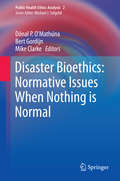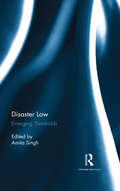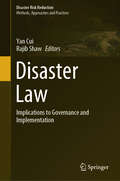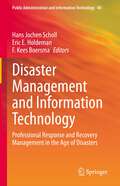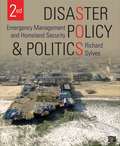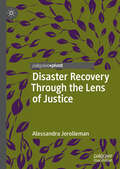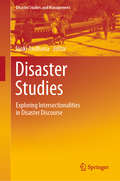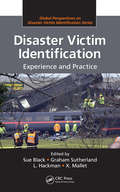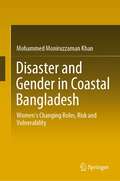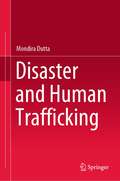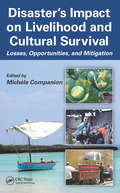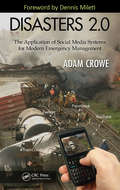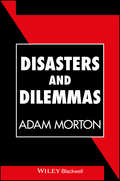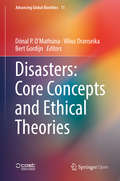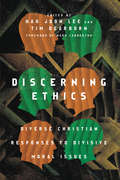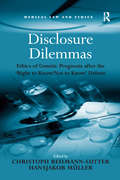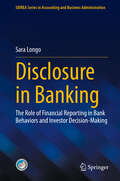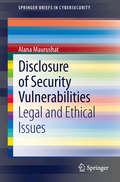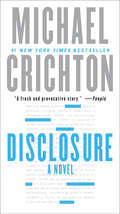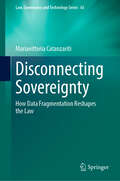- Table View
- List View
Disaster Bioethics: Normative Issues When Nothing is Normal
by Bert Gordijn Dónal P. O'Mathúna Mike ClarkeThis book provides an early exploration of the new field of disaster bioethics: examining the ethical issues raised by disasters. Healthcare ethics issues are addressed in the first part of this book. Large-scale casualties lead to decisions about who to treat and who to leave behind, cultural challenges, and communication ethics. The second part focuses on disaster research ethics. With the growing awareness of the need for evidence to guide disaster preparedness and response, more research is being conducted in disasters. Any research involving humans raises ethical questions and requires appropriate regulation and oversight. The authors explore how disaster research can take account of survivors? vulnerability, informed consent, the sudden onset of disasters, and other ethical issues. Both parts examine ethical challenges where seeking to do good, harm can be done. Faced with overwhelming needs and scarce resources, no good solution may be apparent. But choosing the less wrong option can have a high price. In addition, what might seem right at home may not be seen to be right elsewhere. This book provides in-depth and practical reflection on these and other challenging ethical questions arising during disasters. Scholars and practitioners who gathered at the Brocher Foundation in Geneva, Switzerland in 2011 offer their reflections to promote further dialogue so that those devastated by disasters are respected by being treated in the most ethically soun d ways possible.
Disaster Law
by Kristian Cedervall LautaDisasters and their management are today central to public and political agendas. Rather than being understood as exclusively acts of God and Nature, natural disasters are increasingly analysed as social vulnerability exposed by natural hazards. A disaster following an earthquake is no longer seen as caused exclusively by tremors, but by poor building standards, ineffective response systems, or miscommunications. This book argues that the shift in how a disaster is spoken of and managed affects fundamental notions of duty, responsibility and justice. The book considers the role of law in disasters and in particular the regulation of disaster response and the allocation of responsibility in the aftermath of disasters. It argues that traditionally law has approached emergencies, including natural disasters, from a dichotomy of normalcy and emergency. In the state of emergency, norms were replaced by exceptions; democracy by dictatorship; and rights by necessity. However, as the disaster becomes socialized the idea of a clear distinction between normalcy and emergency crumbles. Looking at international and domestic legislation from a range of jurisdictions the book shows how natural disasters are increasingly normalized and increasingly objects of legal regulation and interpretation. The book will be of great use and interest to scholars and researchers of legal theory, and natural hazards and disasters.
Disaster Law: Emerging Thresholds
by Amita SinghThis book looks at how legal frameworks can and do reduce risks arising out of disasters. The volume: analyses existing disaster laws and the challenges on the ground; brings together case studies from some of the most vulnerable regions; and proposes solutions to avert existing and possible future crises. The book offers appropriate legal frameworks for disaster management which could not only offer sustainable institutional reforms towards community resilience and preparedness but also reduce risk within the frameworks of justice, equity and accountability. It examines the intricacies of governance within which governments function and discusses how recent trends in infrastructure development and engineering technology could be balanced within the legal principles of ethics, transparency and integrity. The chapters in the volume suggest that legal frameworks ought to resonate with new challenges of resource management and climate change. Further, these frameworks could help secure citizens’ trust, institutional accountability and effective implementation through an unceasing partnership which keeps the community better prepared and more resilient. This volume will be indispensable to scholars and researchers of disaster management, law, public policy, environment and development studies as well as policymakers and those in administrative, governmental, judicial and development sectors.
Disaster Law: Implications to Governance and Implementation (Disaster Risk Reduction)
by Yan Cui Rajib ShawThis book covers the broad aspects of disaster legislation, governance, and their implementation. The book also includes in-depth reviews and new data, based on case studies across the globe, involving multidisciplinary research. In addition, the book suggests specific policies and action measures to enhance the implementation of disaster legislation for the resilience of people and local governments. Disaster law is the core to disaster risk management. The legal framework not only provides the government an instrument to take actions before, during, and after a disaster, but it also helps in recovery process. The legislative measures provide certain levels of guidance to different stakeholders such as national governments, local governments, civil societies, and more importantly citizens. The legal provision gives people and communities certain obligations as well as responsibilities to act during or before disasters. Over the last several years, there has been new disaster laws formulated in many countries, and revisions have been made to adjust the existing disaster laws to be more effective. Although it is important to have governance provision of disaster law, its implementation is essential.
Disaster Management and Information Technology: Professional Response and Recovery Management in the Age of Disasters (Public Administration and Information Technology #40)
by Hans Jochen Scholl Eric E. Holdeman F. Kees BoersmaThis edited book entertains a multitude of perspectives on crisis information management systems (CIMS)-based disaster response and recovery management. The use of information technology in disaster management has become the central means for collecting, vetting, and distributing information. It also serves as the backbone for coordination and collaboration between response and recovery units as well as resource management tool. This edited volume aims at covering the whole range of application and uses of CIMS in disaster response and recovery. It showcases coordination and collaboration mechanisms between government agencies, the involvement of non-governmental entities, lessons learned as well as lessons not learned, approaches to disaster resiliency in society, community engagement in disaster/catastrophe responses and recovery, and, particularly, the role of CIMS in response and recovery. Serving as a platform for showcasing recent academic discoveries as well as a knowledge source for practitioners, this volume will be of interest to researchers and practitioners interested in disaster response, public administration, emergency management, and information systems.
Disaster Policy and Politics: Emergency Management and Homeland Security (2nd Edition)
by Richard SylvesDisasters and emergencies challenge people and their governments. Americans routinely want to know how government officials performed during and after events such as the 9/11 terror attacks of 2001; Hurricane Katrina in 2005; the British Petroleum (BP) Deepwater Horizon oil spill in 2010; the Tuscaloosa, Alabama, and Joplin, Missouri tornadoes of 2011
Disaster Recovery Through the Lens of Justice
by Alessandra JerollemanThere has been increased attention to the topics of disaster recovery and disaster resilience over the past several years, particularly as catastrophic events such as Hurricane Katrina and Superstorm Sandy have brought to light the increasing vulnerability of so many communities. This manuscript brings together existing research, along with policy analysis, in order to look at disaster recovery through the lens of justice. This includes understanding the mechanisms through which vulnerability is exacerbated, and the extent to which the regulations and agency cultures drive this outcome. While existing analyses have sought to understand the particular characteristics of both resilient and vulnerable communities, there have been few attempts to understand the systemic inequities and injustice that is built into United States disaster policies, programs, and legislation. This manuscript thus begins from the understanding that social and economic structures, including land use policies and historic practices such as redlining, have concentrated hazard risk into vulnerable zones whose inhabitants do not benefit from the very policies that create and increase their risk.
Disaster Security: Using Intelligence and Military Planning for Energy and Environmental Risks
by Chad M. Briggs Miriam MatejovaThis book is for a broad audience of practitioners, policymakers, scholars, and anyone interested in scenarios, simulations, and disaster planning. Readers are led through several different planning scenarios that have been developed over several years under the auspices of the US Department of Energy, the US Air Force, and continued work at GlobalInt LLC. These scenarios present different security challenges and their potential cascading impacts on global systems - from the melting of glaciers in the Andes, to hurricanes in New York and Hawaii, and on to hybrid disasters, cyberoperations and geoengineering. The book provides a concise and up-to-date overview of the 'lessons learned', with a focus on innovative solutions to the world's pressing energy and environmental security challenges.
Disaster Studies: Exploring Intersectionalities in Disaster Discourse (Disaster Studies and Management)
by Janki AndhariaThis book covers several dimensions of disaster studies as an emerging discipline. It is the inaugural book in the series ‘Disaster Studies and Management’ and deals with questions such as “Is disaster management a field of practice, a profession, or simply a new area of study?” Exploring intersectionalities, the book also examines areas of research that could help enhance the discourse on disaster management from policy and practice perspectives, revisiting conventional event-centric approaches, which are the basis for most writings on the subject. Several case studies and comparative analyses reflect a critical reading of research and practice concerning disasters and their management. The book offers valuable insights into various subjects including the challenge of establishing inter- and multi-disciplinary teams within the academia involved in disaster studies, and sociological and anthropological readings of post-disaster memoryscapes. Each of the contributors has an enduring interest in disaster studies, thus enriching the book immensely. This book will be of interest to all the students and scholars of disaster studies and disaster management, as well as to practitioners and policymakers.
Disaster Victim Identification: Experience and Practice (Global Perspectives on Disaster Victim Identification)
by L. Hackman G. Sunderland X. Mallett S. BlackDisaster management has become an increasingly global issue, and victim identification is receiving greater attention. By raising awareness through past events and experiences, practitioners and policymakers can learn what works, what doesn‘t work, and how to avoid future mistakes. Disaster Victim Identification: Experience and Practice presents a
Disaster and Gender in Coastal Bangladesh: Women’s Changing Roles, Risk and Vulnerability
by Mohammed Moniruzzaman KhanThis volume explores the discourse of disaster and women in the existing social settings and state disaster-related affairs in coastal Bangladesh. It covers various issues ranging from disproportionate vulnerability, coping and adaptation mechanisms for women, limitations for promoting participation and involvement of women in the decision-making process both in family and community and changes in the role and responsibilities of women for reducing disaster risk and vulnerability. It contributes to the deconstruction of gender-based identity by addressing women's changing practices and roles in the coastal area in terms of the involvement of women with the development process, earning/income generation activities, decision-making process, access and entitlements to resources. This book presents the most current and inclusive circumstances of disaster and women of the coastal area in Bangladesh. The insights obtained through the eyes of a sociologist from a holistic perspective make this book different and unique. The book is of interest to researchers, academics, policymakers and professionals engaged in the social understanding of disaster studies, as well as to researchers and practitioners in interdisciplinary domains, including sociology, gender studies, social work, environmental studies, and development studies.
Disaster and Human Trafficking
by Mondira DuttaThe book highlights the root cause of human trafficking and analyses how factors of vulnerability affect the marginalized, especially during and after a disaster. Human trafficking like other studies on disaster research, needs to be tackled from various perspectives such as empowering the vulnerable people, creating awareness, strengthening the disaster risk reduction measures and creating a common platform to fight the vicious circle by breaking its continuity and making strategies victim centric and people friendly.The book adapts a multidisciplinary approach embedding concepts from political, social, economic and anthropological perceptions. The discourse in the book revolves around the emotional and psycho-social stress factors including weak implementation of laws and policies at various levels. The content weaves around three themes -- magnitude and interlinks between disaster and human trafficking; policies and protocols on disaster risk reduction and human trafficking and community participation and institutional support. Through these themes, the volume works on identification of the vulnerable areas which are not in compliance with the Sendai Framework of Action, 2015 in the backdrop of the Disaster Management Act of India, 2005. The volume will be of immense interest to a wide range of practitioners, researchers, academicians, policy makers, political leaders, gender experts, international organizations, disaster management authorities, civil society organisations, and scholars working in the area of human rights in general and trafficking in particular. Note: This research was funded by Indian Council of Social Science Research (ICSSR).Human Trafficking is complex, layered and lies at the intersections of multiple vulnerabilities, gender being among the most significant ones. This gets exacerbated during both natural and human made disasters. Any attempt to either understand or address it will be fraught with challenges if women and girls' unique vulnerabilities, as well as their needs, voice, choice, agency and safety is not centre-staged in any effort. Mondira's book does exactly that...it succinctly and in simple words explores the compounding discriminations, including structural inequalities, that cause and result in women and girls differential gendered vulnerabilities to being trafficked during disasters. Once this is understood, the solutions can be specific, gender responsive, and sustainable.- Anju Dubey Pandey, Gender Responsive Governance and Ending Violence against Women Specialist, UN Women, New Delhi, India
Disaster in the Boardroom: Six Dysfunctions Everyone Should Understand
by Gerry Brown Randall S. PetersonWhy when companies come crashing down, do we hear of boards who have failed in their fiduciary duties? Or that they have been ignorant, complacent or downright complicit in these scandals and downfalls? Of course, corporate scandals are nothing new, nor are they limited to any one geography. They are a damning indictment of our systems of corporate governance around the world. And yet, despite this frequency, little or nothing changes. We shrug and move on, accepting they are an unavoidable part of the system that produces incredible wealth for economies and societies. But it should not be that way. Disaster in the Boardroom shows how boards can be better. Looking at why these scandals happen, authors Peterson and Brown present in-depth case studies of major global corporations – including recent contemporary scandals associated with companies such as BP, Facebook and Uber – using the optic of their unique, original and compelling ‘six dysfunctions of the board’ analysis to reveal their particularities but also how they can be overcome. In this book, Brown and Peterson explore common attributes of scandals such as lack of independence from management, missing key voices, cultural amplification, diffusion of responsibility, rule-bound cultures and groupthink. They also identify ways to strengthen boards, improve their culture and competence, and give directors and others the power to take action and ultimately prevent disasters from happening. Disaster in the Boardroom is essential reading for every executive in every boardroom, those aspiring to board positions as well as anyone interested in why boards fail. It has never been more important to pre-identify and eradicate these boardroom dysfunctions – not least so that their impacts upon society can better seen, understood, mitigated, and avoided.
Disaster's Impact on Livelihood and Cultural Survival: Losses, Opportunities, and Mitigation
by Michèle CompanionMany facets of disasters generate interest among scholars and practitioners. However, a vital area of disaster research is consistently underemphasized. Little is written about the immediate and long-term impacts on a community‘s livelihood systems and the customs and practices of the culture affected. Disaster‘s Impact on Livelihood and Cultural S
Disasters 2.0: The Application of Social Media Systems for Modern Emergency Management
by Adam CroweEmerging social media and so-called Web 2.0 technologies will continue to have a great impact on the practice and application of the emergency management function in every public safety sector. Disasters 2.0: The Application of Social Media Systems for Modern Emergency Management prepares emergency managers and first responders to successfully appl
Disasters and Dilemmas: Strategies for Real-Life Decision Making
by Adam MortonThe author presents a number of strategies for making decisions based on desires or values which are incompatible or which conflict with one another in various ways. Cases discussed include conflicts of first and second order desires, conflicts between desires for present and for future ends, problems deriving from anticipated changes of desire, risk-taking problems, and coordination problems. One central claim of the book is that the same dilemma-managing strategies can be applied to all of these. The book also argues that many of the characteristics of moral dilemmas appear in non-moral decision-making. The relations between these strategies and utility-maximizing decision rules are subtle, and are explored throughout the book. To some extent the strategies apply to cases which are too complicated for utility-maximization to apply. Some of them also apply to the early stages of decision-making where utility-maximization does not enter, for example, in selecting a list of options for serious consideration. In some tidy cases, though, the strategies give different recommendations. This book is meant to have both a theoretical and a practical appeal, deriving from our need for ways of making decisions that do not force us to find trade-offs between goods or values which are hard to compare. The strategies presented in the book are meant to be usable in situations which seem to force decision-makers to balance very different quantities, and the discussion of them is meant as a contribution to debates about incomparable values, moral dilemmas and rational decision.
Disasters: Core Concepts and Ethical Theories (Advancing Global Bioethics #11)
by Bert Gordijn Dónal P. O’Mathúna Vilius DranseikaThis Open Access Book is the first to examine disasters from a multidisciplinary perspective. Justification of actions in the face of disasters requires recourse both to conceptual analysis and ethical traditions. Part 1 of the book contains chapters on how disasters are conceptualized in different academic disciplines relevant to disasters. Part 2 has chapters on how ethical issues that arise in relation to disasters can be addressed from a number of fundamental normative approaches in moral and political philosophy. This book sets the stage for more focused normative debates given that no one book can be completely comprehensive. Providing analysis of core concepts, and with real-world relevance, this book should be of interest to disaster scholars and researchers, those working in ethics and political philosophy, as well as policy makers, humanitarian actors and intergovernmental organizations..
Discerning Ethics: Diverse Christian Responses to Divisive Moral Issues
by Tim Dearborn Hak Joon LeeRacism. Immigration. Gun violence. Sexuality. Health care.
Discipline in Special Education
by Allan G. Osborne Charles J. RussoExperts provide educators with legal guidelines for taking appropriate disciplinary action that can withstand legal challenges without violating the rights of students with disabilities under IDEA 2004.
Disclosure Dilemmas: Ethics of Genetic Prognosis after the 'Right to Know/Not to Know' Debate (Medical Law and Ethics)
by Hansjakob MüllerThere exists today a fast growing availability of personal genetic information. Its prognostic impact and value for an individual or family member's health is sometimes unclear, whilst at other times it is clear-cut. The issue of whether to disclose genetic information does however have wide ranging implications. Avoiding the rhetoric of 'genetic exceptionalism', and drawing on an expanded field of bioethical, sociological and anthropological research, this book sets a new agenda for discussing the ethics surrounding the disclosure of prognostic genetic information. A hermeneutical approach reconsiders the ethics of disclosure in a variety of contexts in which genetic information is generated, requested, interpreted or communicated - from the provider perspective, but also from the moral perspectives of clients and their families. It is in situations of disclosure, in these different contexts, that genetic information meets morality. Providers and recipients can become vulnerable to the revelation or concealment of information, and the forms in which it may be provided. Disclosure Dilemmas invites readers to explore these contexts from an ethical viewpoint and will be a valuable resource for anyone with an interest in biomedical ethics.
Disclosure and Concealment in Consumer Insurance Contracts
by Julie-Ann TarrThis book provides an in-depth examination of the theoretical,legal, social and economic foundations to disclosure and concealment of information in relation to the formation of consumer insurance contracts. A comparative treatment of this issue is undertaken with particular attention given to the judicial and legislative approaches adopted in the United Kingdom, the United States of America, Australia and New Zealand. It will be relevant to those researching and studying insurance law, all legal practitioners involved with the formation of consumer insurance contracts and non-legal practitioners working within the field of insurance.
Disclosure in Banking: The Role of Financial Reporting in Bank Behaviors and Investor Decision-Making (SIDREA Series in Accounting and Business Administration)
by Sara LongoDisclosure represents an evergreen topic in banking since it allows breaking down the opacity of the so-called “black box” banks. The recent failures of Silicon Valley Bank and Credit Suisse in March 2023 have reignited discussions about the role played by banking disclosure and its link to transparency, financial stability, and competition. Given these premises, this book comprehensively explains how banking disclosure has evolved in the last decades, shaping banks’ behaviors and mainly investors' decision-making. The book provides an in-depth review of the field, highlighting theories and empirical studies about banking disclosure grounded on regulatory mandates and voluntary initiatives mitigating agency conflicts and addressing information asymmetries. Then, this book discusses banks' need to enhance their disclosure practices to comply with stress tests and contribute to sustainable development, particularly in light of climate change risk. To this end, an empirical investigation uncovers banks scrutinized by regulators and supervisors are more inclined to engage in green lending and prioritize borrowers’ ESG disclosures, thus promoting a more sustainable economy. Lastly, this book presents the state of the art about the link between banking disclosure and sustainability, suggesting potential avenues for future research.
Disclosure of Security Vulnerabilities
by Alana MaurushatMuch debate has been given as to whether computer security is improved through the full disclosure of security vulnerabilities versus keeping the problems private and unspoken. Although there is still tension between those who feel strongly about the subject, a middle ground of responsible disclosure seems to have emerged. Unfortunately, just as we've moved into an era with more responsible disclosure, it would seem that a market has emerged for security vulnerabilities and zero day exploits. Disclosure of Security Vulnerabilities: Legal and Ethical Issues considers both the ethical and legal issues involved with the disclosure of vulnerabilities and explores the ways in which law might respond to these challenges.
Disclosure: A Novel
by Michael CrichtonFrom the author of Jurassic Park, Timeline, and Sphere comes an electrifying thriller in which a shocking accusation of sexual harassment triggers a gripping psychological game of cat and mouse and threatens to derail a brilliant career. #1 NEW YORK TIMES BESTSELLER "A fresh and provocative story."--People An up-and-coming executive at the computer firm DigiCom, Tom Sanders is a man whose corporate future is certain. But after a closed-door meeting with his new boss--a woman who is his former lover and has been promoted to the position he expected to have--Sanders finds himself caught in a nightmarish web of deceit in which he is branded the villain. As Sanders scrambles to defend himself, he uncovers an electronic trail into the company's secrets--and begins to grasp that a cynical and manipulative scheme has been devised to bring him down. "Crichton writes superbly. . . . The excitement rises with each page."--Chicago Tribune "A heart-stop story running on several tracks at once. Disclosure is up to [Crichton's] usual locomotive speed."--The Boston Globe "Expertly crafted, ingenious and absorbing."--The Philadelphia Inquirer
Disconnecting Sovereignty: How Data Fragmentation Reshapes the Law (Law, Governance and Technology Series #65)
by Mariavittoria CatanzaritiThis book explores the dynamic legal semantics of territory as applied to data. It offers a theoretical assessment of the legal challenges that data flows pose for the principle of territoriality and for state sovereignty more generally. The concept of sovereignty has traditionally developed in close connection with the exercise of powers over a territory, and ideas of jurisdiction have always been based on the principle of territoriality. Digitalization questions however the very idea of physical frontiers. Interconnected networks make data in effect borderless. Data can in fact be created, stored, processed, and accessed anytime and from anywhere. The idea of the book is upbeat: the law can keep pace with the ability of data to fragment reality. The condition for this is that sovereignty disconnects from territory. Disconnection is not getting rid of the territory once and for all, it only means that for data alternatives to the territorial connection exist. The analysis focuses on data from a holistic perspective (personal and nonpersonal) with the aim of investigating divergent and convergent solutions provided by different branches of the law (data protection, IP law, international law, and fundamental rights protection). It assesses in particular, the relationships between digitalization and the principle of territoriality, focusing on the specific legal aspects: the connections between law and territory; the impact of digitalization on state sovereignty; the use of extraterritoriality to circumvent territorial limitations on data flows; the rise of digital jurisdiction and its challenges; the interplay between digital jurisdiction and state sovereignty, and the alternative technological and legal solutions to data localization.
